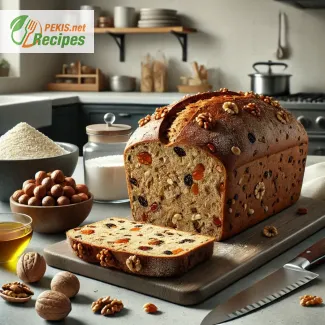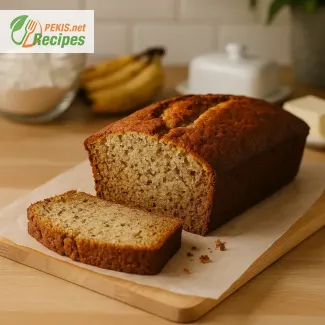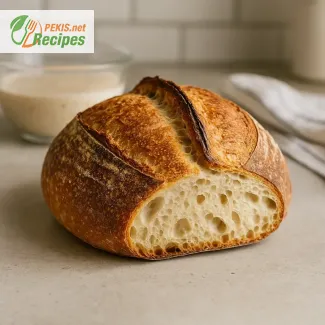Makes 10 slices. Prep 20 min, bake 40 min, total 60 min. Rye bread with nuts and dried fruit delivers a dense yet moist crumb with a satisfying crunch from walnuts and almonds balanced by the natural sweetness of raisins and figs. The loaf stays fresh at room temperature for 2 days, can be frozen for 2 months, and reheats perfectly at 150 °C for 8–10 minutes. Ideal for breakfast, cheese boards, or open-faced sandwiches, this rustic bread combines wholesome flavor, texture, and tradition in every slice.

Rustic rye bread enriched with nuts and dried fruits
A wholesome loaf with texture and tradition
Dense, aromatic, and full of character, rye bread with nuts and dried fruit captures the essence of rustic baking. The deep, slightly tangy flavor of rye flour forms the foundation of this loaf, while crunchy walnuts, hazelnuts, or almonds bring a nutty richness. Chewy dried fruits such as figs, raisins, or apricots provide natural sweetness and bursts of flavor in every slice, creating a loaf that feels both nourishing and indulgent at the same time.
This type of bread has roots in Central and Northern Europe, where rye flour has been a staple grain for centuries due to its resilience in cooler climates. Traditionally baked in wood-fired ovens, rye loaves were often enriched with nuts and fruit during festive times or for long winters, as dried produce stored well and added both nutrition and flavor. Today, the combination remains timeless, balancing rustic heritage with modern taste preferences.
Why this recipe stands out
- Crunchy texture from roasted nuts contrasts beautifully with the dense crumb of rye.
- Natural sweetness of dried fruit means less added sugar is needed.
- Hearty and filling, making it perfect for breakfast, snacks, or alongside cheese boards.
- Longer shelf life compared to white bread, thanks to the rye flour and dried fruit.
- Versatility in pairings: excellent with soft cheese, smoked meats, or even just butter.
Storage and make-ahead tips
- Store at room temperature for up to 2 days wrapped in a clean kitchen towel.
- Freeze slices or whole loaves for up to 2 months; thaw at room temperature.
- To refresh, warm in the oven at 150 °C (300 °F) for 8–10 minutes to restore crust crispness.
Ingredient influences and texture notes
- Rye flour delivers a darker, earthier flavor than wheat, giving the loaf its characteristic density and depth.
- Nuts such as walnuts, almonds, or hazelnuts provide crunch, richness, and a nutty aroma. Toasting them beforehand enhances their flavor.
- Dried fruits like raisins, figs, cranberries, or apricots add chewiness and a subtle sweetness that balances rye’s natural tang.
- Seeds (optional) such as sunflower or pumpkin can boost crunch and rustic appearance.
- A touch of honey or molasses complements the dried fruit and deepens the flavor of rye.
Creative variations to try
- Replace raisins with dried cranberries for a tangier note.
- Swap walnuts for toasted hazelnuts to bring a rounder, slightly sweeter flavor.
- Add pumpkin seeds for extra crunch and autumn appeal.
- Infuse the dough with spices like cinnamon or anise for a festive touch.
- Shape into small rolls instead of one large loaf for single-serve portions.
Why you’ll love this bread
- Easy to slice without crumbling.
- Delicious toasted with butter or nut spreads.
- Works equally well for savory or sweet pairings.
- Brings a sense of tradition and homeliness to the table.
Serving inspiration
- Perfect companion to a cheese platter, especially with blue cheese or brie.
- Slice thinly and serve with smoked salmon for a Scandinavian-style snack.
- Enjoy as a breakfast toast with honey, jam, or almond butter.
- Use as the base for open-faced sandwiches topped with roasted vegetables or cured meats.
This rustic loaf combines heritage with flavor, delivering a crunchy treat that fits both everyday meals and festive occasions.
- Mix warm water, dry yeast, and honey in a large bowl. Let it sit for 10 minutes until foamy.
- Add rye flour, bread flour, and salt. Knead into a smooth dough for about 8–10 minutes.
- Fold in chopped walnuts, almonds, raisins, and figs. Mix until evenly distributed.
- Cover and let the dough rise in a warm place for 1 hour or until doubled in size.
- Shape into a round loaf and place on a baking tray lined with parchment paper.
- Brush lightly with olive oil and sprinkle with extra nuts if desired.
- Bake in a preheated oven at 200 °C (390 °F) for 40 minutes, until golden brown and hollow when tapped.
- Cool on a wire rack before slicing.
FAQ questionCan I use only rye flour for this bread?
Yes, but the texture will be much denser. Combining rye flour with bread flour gives the loaf better structure and rise while still keeping the earthy rye flavor.
FAQ questionWhich nuts and dried fruits work best?
Walnuts, almonds, and hazelnuts pair beautifully with raisins, figs, apricots, or cranberries. You can mix and match depending on what you like or have at home.
FAQ questionHow do I prevent the dried fruit from sinking to the bottom?
Coat the chopped fruit lightly in flour before folding it into the dough. This helps distribute it evenly throughout the loaf.
FAQ questionCan this bread be made in advance?
Absolutely. It stays fresh for 2 days at room temperature, can be frozen for up to 2 months, and reheated at 150 °C (300 °F) for 8–10 minutes.
FAQ questionWhat can I serve with this bread?
It’s delicious with butter, soft cheeses, smoked salmon, or even as the base for open-faced sandwiches with roasted vegetables or cured meats.
PEKIS – professional chef and recipe developer with more than 25 years of experience, specialized in European and international cuisine. For this rye bread with nuts and dried fruit, I draw on years of working with traditional artisan loaves and experimenting with different textures and flavor pairings, creating a bread that is both rustic and versatile.
A warm slice of rye bread with nuts and dried fruit carries the best of rustic baking: the earthy depth of rye flour, the crunch of toasted walnuts and almonds, and the natural sweetness of raisins and figs. This balance of flavors and textures makes every bite both hearty and comforting.
The loaf is built to last, staying moist and flavorful for days while keeping its crisp crust. With simple reheating, it regains the aroma and taste of fresh-baked bread, making it as enjoyable the second time as the first. Its ability to freeze well also means there is always a wholesome loaf on hand.
Every slice works in multiple ways – served plain with butter, layered with cheese and cured meats, or toasted for breakfast with honey or jam. The bread adapts effortlessly from everyday meals to special gatherings, offering a versatile base for countless pairings.
With its blend of tradition and creativity, this bread speaks to the heritage of European baking while fitting perfectly into modern kitchens. The addition of nuts and fruit elevates the humble rye loaf into something memorable, flavorful, and deeply satisfying.
Bringing together the qualities of texture, flavor, and practicality, rye bread with nuts and dried fruit stands as a loaf that delivers nourishment, comfort, and timeless appeal.
Allergens present in the recipe:
- Gluten (rye flour, bread flour)
- Tree nuts (walnuts, almonds)
Suggestions for substitutions:
- Replace rye and bread flour with certified gluten-free flour mix to avoid gluten.
- Replace walnuts and almonds with sunflower seeds or pumpkin seeds for a nut-free version.
- Use maple syrup instead of honey for a vegan-friendly alternative.
- Vitamin B1 (Thiamine): 0.2 mg – supports energy metabolism and nervous system.
- Vitamin E: 1.5 mg – contributes to skin and cell protection.
- Magnesium: 45 mg – important for muscle and nerve function.
- Iron: 2 mg – supports red blood cell formation.
- Potassium: 200 mg – helps regulate fluid balance and blood pressure.
- Polyphenols from dried fruit: 80 mg – support heart health and reduce inflammation.
- Vitamin E from nuts: 1.5 mg – protects cells from oxidative stress.
- Flavonoids from figs and raisins: 70 mg – may improve circulation and reduce free radical damage.





